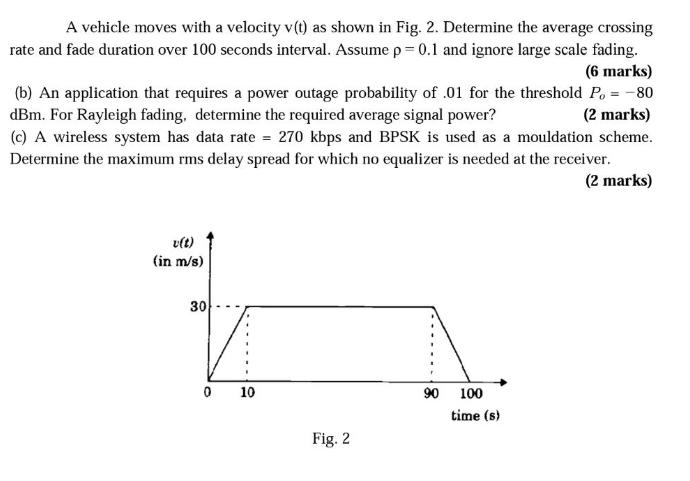Answered step by step
Verified Expert Solution
Question
1 Approved Answer
A vehicle moves with a velocity v(t) as shown in Fig. 2. Determine the average crossing rate and fade duration over 100 seconds interval.

A vehicle moves with a velocity v(t) as shown in Fig. 2. Determine the average crossing rate and fade duration over 100 seconds interval. Assume p = 0.1 and ignore large scale fading. (6 marks) (b) An application that requires a power outage probability of .01 for the threshold P. = -80 dBm. For Rayleigh fading, determine the required average signal power? (2 marks) (c) A wireless system has data rate= 270 kbps and BPSK is used as a mouldation scheme. Determine the maximum rms delay spread for which no equalizer is needed at the receiver. (2 marks) v(t) (in m/s) 30 0 10 Fig. 2 90 100 time (s) A vehicle moves with a velocity v(t) as shown in Fig. 2. Determine the average crossing rate and fade duration over 100 seconds interval. Assume p = 0.1 and ignore large scale fading. (6 marks) (b) An application that requires a power outage probability of .01 for the threshold P. = -80 dBm. For Rayleigh fading, determine the required average signal power? (2 marks) (c) A wireless system has data rate= 270 kbps and BPSK is used as a mouldation scheme. Determine the maximum rms delay spread for which no equalizer is needed at the receiver. (2 marks) v(t) (in m/s) 30 0 10 Fig. 2 90 100 time (s)
Step by Step Solution
★★★★★
3.37 Rating (147 Votes )
There are 3 Steps involved in it
Step: 1
4a Average Crossing Rate and Fade Duration To determine the average crossing rate and fade duration ...
Get Instant Access to Expert-Tailored Solutions
See step-by-step solutions with expert insights and AI powered tools for academic success
Step: 2

Step: 3

Ace Your Homework with AI
Get the answers you need in no time with our AI-driven, step-by-step assistance
Get Started


